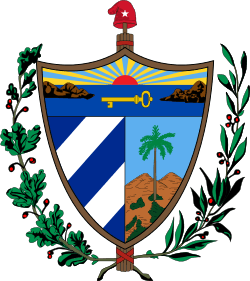Jefferson Caffery
Jefferson Caffery (December 1, 1886 – April 13, 1974) was a distinguished American diplomat. He served as U.S. ambassador to El Salvador (1926–1928), Colombia (1928–1933), Cuba (1934–1937), Brazil (1937–1944), France (1944–1949), and Egypt (1949–1955).
Career
Caffery launched his career of international diplomacy in 1911 when he entered the Foreign Service as second secretary of the legation in Caracas in 1911 during the William Howard Taft administration.
He traveled to Iran (then named Persia) in 1916, to Paris after World War I with President Wilson’s peacemakers, then to Washington, D.C., to arrange details for visits by the King of Belgium and the Prince of Wales. In 1920, he was named second-in-command at the U.S. Embassy in Madrid. In 1933, Caffery briefly served as assistant secretary of state under Cordell Hull. Throughout his career he also had worked in lower-ranking diplomatic posts in Belgium, Germany, Greece, Japan, Persia, Sweden, and Venezuela.
As the U.S. ambassador to Colombia, Jefferson was heavily involved in the Banana Massacre that occurred in 1928 in the small, coastal town of Ciénaga. Tired of terrible working conditions and very little wages (workers were paid in United Fruit Company store credit), banana farmers went on strike in protest. In order to protect the interests of the United Fruit Company, Caffery reported to U.S. Secretary of State Frank Billings Kellogg that leaders of the strike would be immediately arrested and sent to prison in nearby Cartagena. Martial law was declared soon after and an unknown number of workers and their families were shot by a firing squad in the town square.[1]
In 1934, while ambassador to Cuba, four assailants attempted to assassinate Caffery in front of his home in Havana. The assailants waited outside of his residence for his daily departure to his yacht club. One assailant was killed by a bodyguard, the others escaped. Caffery was not hurt. The event was reported on the front page of the New Orleans Times Picayune, dated May 28, 1934.
In total, he worked 43 years in foreign service under eight U.S. presidents: Taft, Wilson, Harding, Coolidge, Hoover, F. D. Roosevelt, Truman, and Eisenhower.
He was awarded the Foreign Service Cup in 1971 by his fellow Foreign Service officers. He held several honorary degrees and decorations, including the Laetare Medal from the University of Notre Dame in South Bend, Indiana, in 1954. He received the Grand Cross of the Legion of Honor from the president of France in 1949 and the Order of the Cordon of the Republic from the president of Egypt in 1955.
Personal life
Caffery was born in Lafayette, Louisiana to Charles Duval Caffery and Mary Catherine (Parkerson) Caffery. He was privately educated in primary and secondary school. He was a member of the first graduating class of Southwestern Louisiana Industrial Institute, which later became the University of Louisiana at Lafayette. He also graduated with a bachelor's degree from Tulane University in 1906. He was admitted to the Louisiana bar in 1909.
Caffery married Gertrude McCarthy of Evansville, Indiana in 1937 while in Rio de Janeiro. They had no children. He retired with his wife in 1955 to reside in Rome, where he was the honorary private chamberlain to Popes Pius XII, Pope John XXIII, and Paul VI. He returned to Lafayette in 1973, shortly before Mrs. Caffery's death.
The Cafferys are buried behind St. John’s Cathedral in Lafayette. Ambassador Caffery was also bestowed knighthood in the Sovereign Military Order of Malta (SMOM) by the Grand Master of that Order, for his outstanding service to the Catholic Church.
Caffery was the cousin of U.S. Senator Donelson Caffery and U.S. Representative Patrick Caffery
Posthumous recognition
A portion of Louisiana Highway 3073 in Lafayette is named the "Ambassador Caffery Parkway" in his memory. In 2000, Caffery was inducted into the Louisiana Political Museum and Hall of Fame in Winnfield.[2]
See also
References
- ↑ Koeppel, D. (n.d.). Banana : The fate of the fruit that changed the world. New York: Hudson Street Press.
- ↑ "Louisiana Political Museum and Hall of Fame". cityofwinnfield.com. Retrieved August 22, 2009.
- "Jefferson Caffery". A Dictionary of Louisiana Biography. 1. New Orleans, La.: Louisiana Historical Association. 1988. p. 141. ISBN 0-940984-37-7. OCLC 18400915.
- Dur, Philip F. (1974). "Jefferson Caffery of Louisiana: Highlights of His Career, Part I: 1911-1933". Louisiana History. Louisiana Historical Association. XV. ISSN 0024-6816. OCLC 1782994.
- Dur, Philip F. (1974). "Jefferson Caffery of Louisiana: Highlights of His Career, Part II: 1933-1944". Louisiana History. Louisiana Historical Association. XV. ISSN 0024-6816. OCLC 1782994.
- Corrigan, Robert Foster (November 1967). "An Appreciation of a Diplomat". Foreign Service Journal. Washington: American Foreign Service Association. ISSN 0146-3543.
- Ambassador Caffery Bio
External links
- Cemetery Memorial by La-Cemeteries
- A film clip "Third Army blasts Nazi Strongholds, 1944/11/02 (1944)" is available at the Internet Archive
| Diplomatic posts | ||
|---|---|---|
| Preceded by Montgomery Schuyler, Jr. |
U.S. Minister to El Salvador 20 July 1926–22 July 1928 |
Succeeded by Warren D. Robbins |
| Preceded by Samuel H. Piles |
United States Minister to Colombia 28 November 1928–20 May 1933 |
Succeeded by Sheldon Whitehouse |
| Preceded by Sumner Welles |
United States Ambassador to Cuba 1934-1937 |
Succeeded by J. Butler Wright |
| Preceded by Hugh S. Gibson |
United States Ambassador to Brazil 17 August 1937–17 September 1944 |
Succeeded by Adolf A. Berle, Jr. |
| Preceded by William D. Leahy (to 1942) |
United States Ambassador to France 1944-1949 |
Succeeded by David K. E. Bruce |
| Preceded by Stanton Griffis |
United States Ambassador to Egypt 1949-1955 |
Succeeded by Henry A. Byroade |
